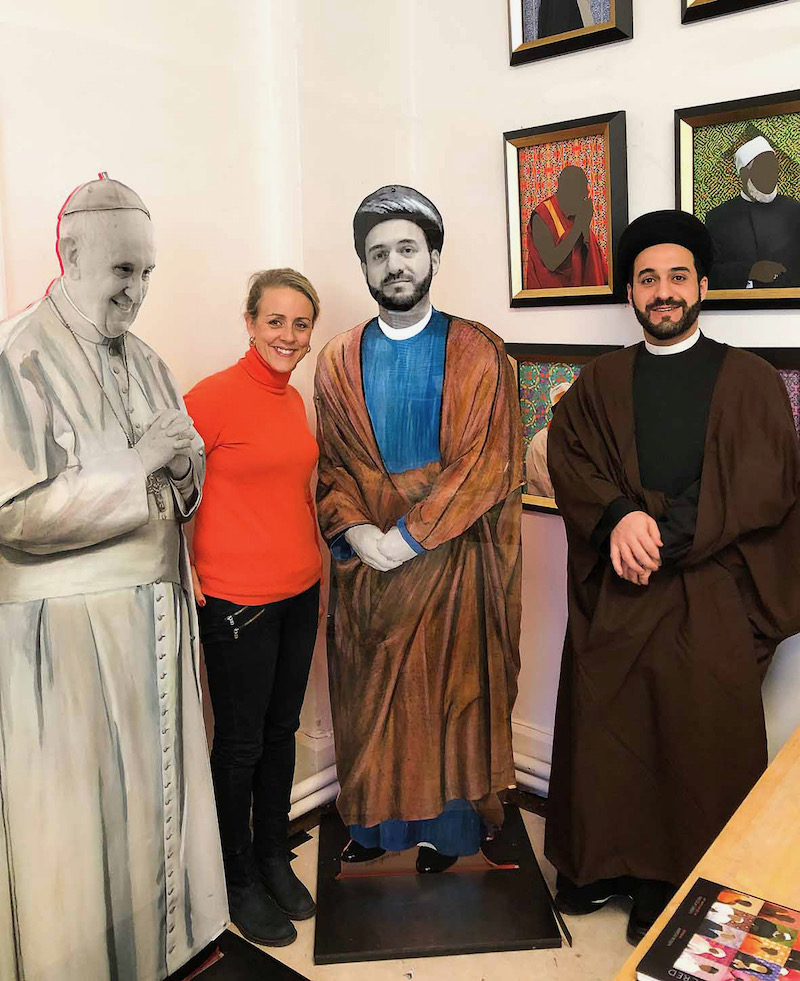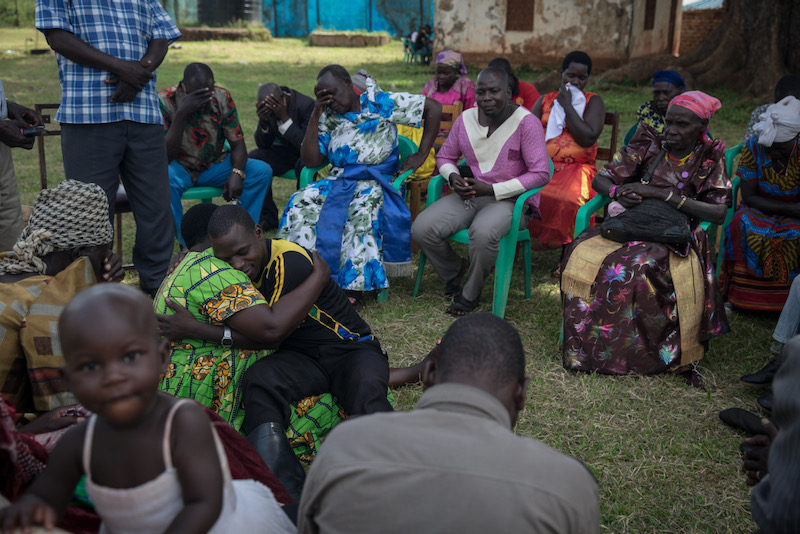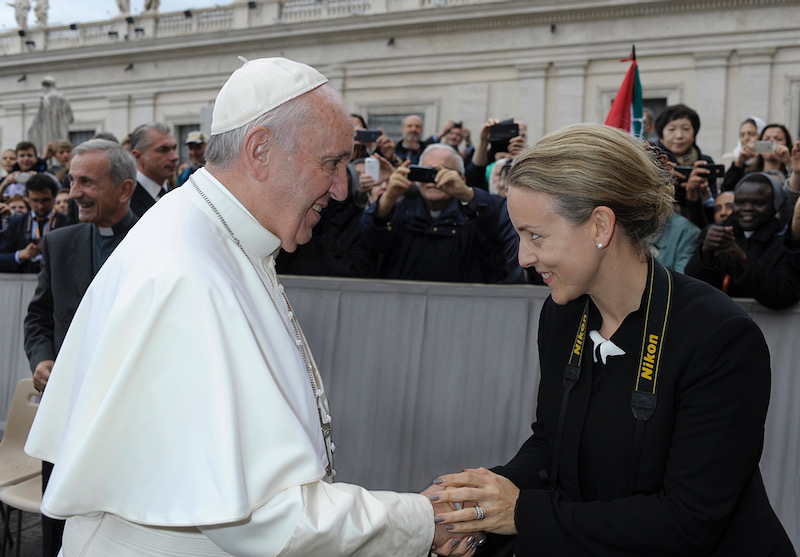Art’s relationship to the divine predates any of the monotheistic faiths, but it has been out of fashion for a while in the individualist West. In the twentieth century, cubism, abstract expressionism and conceptualism were the new obsessions for the most celebrated painter-maker heroes and heroines, while religion took a backseat.
Those of us who still interested in the aesthetics of religion, what it means to show yourself in the colours of a faith, are in the minority, but that has its advantages. When in 2008 I asked the then-Archbishop of Canterbury, Dr Rowan Williams, to let me record his private meeting with the Dalai Lama in 2008, his reaction was one of surprise. He said yes. Paintings and photographs are records, but not obviously commentary. I doubt I’d have been given the same access if I’d been a writer.
It was a remarkable experience. I was alone with the two men as they sat on a sofa in the Archbishop’s book laden office in Lambeth Palace, holding hands, discussing complex world issues.
I have since been present at a series of historic private meetings between spiritual leaders around the world; between Popes and Zoroastrians, between Chief Rabbis and Grand Muftis, between Archbishops and Swamis. In some 22 trips across the Middle East, Europe, the United States and India, I have been to the inner sanctums of the Vatican, the Western Wall in Jerusalem, and Al-Azhar University in Cairo at the height of the Arab Spring in 2011. During this time, I’ve taken nearly 10,000 photographs and made countless sketches, drawings and notes working as a social historian, as well as an artist, documenting the religious leaders moving slowly towards each other.
I am married to a politician. I have painted presidents and prime ministers. Every time I’m in those rooms, I see first-hand the pacts that politicians make with journalists, the mediation that gives the public some, not all, of what it needs to know. They live in the business of overpromising, finding short-term fixes, reducing complexity to a soundbite. But as politics has become more partisan, polarised and populist, it has also become more showy with buses, flags, and ruffled hair. A better kind of symbolism is religious in spirit. It reverences unified understanding.
Few encounters between religious figures in modern history have sent such a publicly unifying message as the meeting in Iraq between Pope Francis and the Grand Ayatollah Ali al-Sistani, spiritual leaders respectively representing Catholics and Shia Muslims around the world. This conversation was a decade in the making. Finding the language, in Al-Sistani’s modest home in the Iraqi city of Najaf, to support each other’s religions without undermining the truth of their own, has been a painful process, which I have witnessed up close. Speaking as a religious leader about another absolute truth requires unprecedented and deep reflection. Speaking publicly in support of another faith, against the backdrop of violent persecution on both sides, sends a powerful message of peace.
Modern politicians are individualistic representatives. Religious leaders are highly representative individuals – people through whom the faith speaks, but whose personality is not the point. Their clothing, accoutrements and gestures are not theirs alone. They are symbols far more than they are modes of expression. Pope Francis chose to travel to Iraq and to leave his shoes at the door as a mark of respect to Sistani and Shia Islam. He knows that sharing a physical platform with Sistani, or travelling afterwards to Ur, birthplace of Abraham and meeting-point for the Abrahamic faiths, constitutes a historic gesture. It reminds the world of the equality of status that should exist between Western and Eastern religious leaders.
 Sayyed Jawad Al-Khoei and Nicola Green in her London studio with life size paintings on Perspex.
Sayyed Jawad Al-Khoei and Nicola Green in her London studio with life size paintings on Perspex.
Interfaith dialogue has not always offered grounds for hope. The first meeting of leaders in 1893 at the Parliament of World Religions in Chicago raised an outcry in the press. Many Americans were horrified by the idea of Christians, Muslims, Jews and Hindus sharing the same space. Interfaith organisations began nevertheless to emerge only to fall back in the shadow of the Holocaust, the century’s defining catastrophe.
But in the aftermath of the Second World War, Pope Paul VI took a stride forward. Nostra Aetate (In Our Time), the “declaration on the relation of the Church to non-Christian religions” ratified at the Second Vatican Council of 1965, opened the door to more positive engagement with non-Christians, and Jews in particular. Martin Luther King made further progress the same year as he walked with Jewish and other religious leaders across the Edmund Pettus bridge in Selma, showing that he understood the need for religious unity in the Civil Rights movement. Desmond Tutu and Nelson Mandela followed his example. Both men credited religious unity with shifting the tide of world opinion against apartheid in South Africa in the 1980s
But arguably there were no major efforts to bridge religious divides until Pope John Paul II invited 60 religious leaders to Assisi, in southern Italy, in 1986, for the first World Day of Prayer – a response to the escalation of Cold War tension between the Eastern bloc and the West, and the apparent failure of détente. Again, the global media response was a sort of horrified scepticism. What might it mean when different religions came together, even as politicians did not?
In the wake of 9/11 and the so-called War on Terror that followed, there has been a marked increase in non-military violence directed against Muslims, as well as Sikhs and other ethno-religious groups, through the developed world. At the same time, this 21st century crisis of integration (and, to be sure, immigration) has inspired many different religious leaders across the world to focus on working together. In recent years, while the populist nationalists have been building walls, religious leaders have been quietly cultivating common ground.
We can be suspicious of religious dogma. Some atheists have strong anti-religious beliefs, and not without reason: the battle for territory and advantage has often taken place behind a religious symbolic standard. Rights for minorities in the twentieth century have been hard won, and organised faith has often been a block to progress and self-actualisation. Yet secularisation has not exploded across the world as many in the West once believed it would. In fact, religion is on the rise and secularism is now largely confined to Northern Europe, the East Coast of America, and Australasia. Four-fifths (84 per cent) of the world’s population currently identifies as having a faith.
It is not that interfaith dialogue has suddenly won a sweeping victory over intolerance. But Pope Francis and Ayatollah Sistani’s meeting this week reflects what I have seen and recorded in many countries over the past decade. In these troubling times there is an unprecedented willingness among religious leaders to engage in genuine, constructive dialogue. It is a historic development, and we should welcome it.
Nicola Green is an artist whose work includes Encounters Artwork Series and the academic book Encounters: The Art of Interfaith Dialogue.



 Loading ...
Loading ...
What do you think?
You can post as a subscriber user ...
User comments (0)